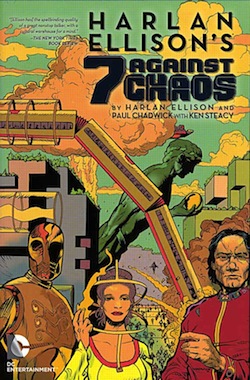When I told a poet friend of mine I was reading a new Harlan Ellison graphic novel, she raised an eyebrow and said, “I respect that,” and then, “he’s still writing?” The idea that a new Harlan Ellison graphic novel exists, much less could be relevant, is a damn dubious. Though he is one of the pioneers of New Wave SF, Harlan Ellison hasn’t been new for awhile and “probably is the most contentious person now walking the Earth.”
That last tidbit isn’t slander, as it comes straight from Ellison’s bio on the dust jacket of 7 Against Chaos, the new graphic novel from Ellison and artist Paul Chadwick (and Ken Steacy). And like Ellison himself, there’s something both angry and original about what’s contained within. It’s also totally engrossing.
Set in a far, far future that seems like a blend of an Asimov/Heinlein/Alfred Bester style-universe, a bunch of humans have been “re-ordered” in various ways including but not limited to: looking like insects, having powers like a Phoenix, being telepathic, etc. This is a little like mutants in the X-Men, only, in this case we created them. Naturally, these folks got exploited at some point and big wars were fought over it. A famous war hero later turned against the powers-that-be because he wanted to stick up for the insect-people, phoenixes and such. His name is Roark and he is kind of the main character of the book. And he’s one of the seven against chaos.
The other six are: Tatatalus (an insect man), Mourna (a 7-foot tall gal with metal pinchers for hands), Lady Ayleen (a Phoenix), URR (a friendly robot), Hoorn (a faceless cat-burglar), and Kenrus (a scientific genius who slightly resembles Harlan Ellison!). They are all recruited at the start of the book by Roark not because he thinks it’s a good idea, but because he’s following the direction of something called The Crisis Computers. Think of these as a kind of Space Nate Silver: they make predictions about the future and are seldom wrong, though sometimes they’re not super specific about what’s going down. Roark only knows he has to recruit the six people to help him thwart an evil plot to destroy Earth.
An evil plot, you say? Isn’t that a little cliché? Well yes, it is a little. But the evil plot is both one you’ve somehow already heard of, yet never seen realized this way: intelligent reptile people want to go back in time and change history to make sure reptiles become dominant over mammals. There’s a lot of mumbo jumbo about how the paradoxes of changing history are being sustained which definitely will remind Doctor Who fans of The Master’s Paradox Machine from “The Sound of Drums.” The perpetrator of this evil plot is a lone lizard-man named Erissa (two “s’s” cause he’s part sssssnake!). Why Erissa hates humans so much isn’t really clear, nor do we hear much about the Crisis Computers once the 7 Against Chaos start fighting the Chaos.
Tonally, the book is all over the place. I wasn’t sure which science fiction idea I was meant to focus on. Paradoxes? Evil Lizards? Awesome powers? Ethical Robots? This isn’t necessarily a problem in this sort of thing, and all the concepts do help to make for a fully realized science fiction world. Charmingly, this world feels like a future Ellison would have dreamed up in the 1960s. This isn’t to say it’s anachronistic, simply that there’s something old-fashioned to the heroics and characterizations. Do any of these nifty characters get developed and change and grow? No! They’re way too busy running from monsters, lizards, and space-stuff! If you’re hoping a 7-foot tall woman with metal pinchers for hands has some deep emotional conflict, you’re going to be disappointed. Moura is a nice person and has metal pinchers for hands. That’s her whole character. It’s not sexist or bad, it’s just flat. Weirdly, all the others characters are too, which is odd for Ellison, since he’s capable of writing richly complicated people.
But, I sensed that wasn’t what he was going for here. The art from Paul Chadwick reminded me Al Williamson’s work on Flash Gordon and vintage Star Wars comics. For this reason, the whole feel of 7 Against Chaos is like those wiz-bang serials that influenced so many purveyors of science fiction and science fantasy in the previous century. But, Ellison marries that sensibility with plausible science fiction. Nothing feels magical or destined here, and not everything works out in an archetypal fashion. Indeed, the majority of the characters end up dead, and the ones who remain might not even be heading toward their own version of Earth. Bummer!
It might be a stretch, but I felt as though Ellison’s own realities were converging here. One dimension is Ellison eternally young like his character Jefty from the short story “Jefty is Five.” This Ellison loves movie serials and Flash Gordon and was excited to meet Isaac Asimov as a young man. But, the other dimension is the older, grumpier Ellison, too intelligent for his own good, and angry about it. In many ways 7 Against Chaos is both trying to have fun with life and shake its fist at death. Are we meant to be excited about the ray guns wiz-pow action, or is it all a smoke screen for feeling sad and nostalgic about a future era which has paradoxically passed us by?
Well, maybe sometimes a Ray Gun is just a Ray Gun. Unless of course it’s not, and the Ray Gun represents aging, despair, and how we will all lose our loved ones.
Oh, and lizard people too.
Ryan Britt is a longtime contributor to Tor.com, marvels at Ellison’s vocabulary, and might me a lizard person.










